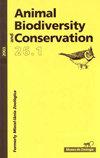Increases in avian diversity associated with COVID-19 lockdowns in urban Colombia
IF 1
4区 环境科学与生态学
Q3 BIODIVERSITY CONSERVATION
引用次数: 0
Abstract
Research on urban biodiversity has primarily addressed the effects of urbanization and human activity synergistically as it has been virtually impossible to dissociate their impact on city wildlife. However, the anthropause resulting from COVID–19 lockdowns provided an unprecedented scenario to study the relative role of human activity on avian communities. Here we provide evidence of the relationships between human activity and bird species richness in urban areas of Colombia during its strict and subsequent relaxed lockdowns. Once the strict lockdown was lifted and human activity increased, avian species richness decreased by 32 % in 46 % of our sampling sites. Although the strict lockdown lasted only six weeks, local assemblages (mainly from low–intensity urbanization peri–urban sites) swiftly became more diverse. Our findings highlight the importance of taking human activity into account when planning cities, with important focus on greenspaces, if our aim is to conserve and enhance urban biodiversity. Such plans will require not only the cooperation of local governments but also greater awareness among the local population regarding the importance of creating livable, healthy, biodiverse, and resilient cities.与哥伦比亚城市COVID-19封锁相关的鸟类多样性增加
对城市生物多样性的研究主要是协同处理城市化和人类活动的影响,因为几乎不可能将其对城市野生动物的影响分开。然而,2019冠状病毒病封锁导致的人类停顿为研究人类活动对鸟类群落的相对作用提供了前所未有的场景。在这里,我们提供了哥伦比亚城市地区在严格和随后放松封锁期间人类活动与鸟类物种丰富度之间关系的证据。一旦严格的封锁解除,人类活动增加,我们46%的采样点的鸟类物种丰富度下降了32%。尽管严格的封锁只持续了六周,但当地的组合(主要来自低强度的城市化周边地区)迅速变得更加多样化。我们的研究结果强调了在规划城市时考虑人类活动的重要性,如果我们的目标是保护和增强城市生物多样性,就要重点关注绿地。这些计划不仅需要地方政府的合作,还需要当地民众对创建宜居、健康、生物多样性和韧性城市的重要性有更高的认识。
本文章由计算机程序翻译,如有差异,请以英文原文为准。
求助全文
约1分钟内获得全文
求助全文
来源期刊

Animal Biodiversity and Conservation
农林科学-动物学
CiteScore
2.00
自引率
0.00%
发文量
21
审稿时长
>12 weeks
期刊介绍:
Animal Biodiversity and Conservation (antes Miscel·lània Zoològica) es una revista interdisciplinar, publicada desde 1958 por el Museu de Ciències Naturals de Barcelona. Incluye artículos de investigación empírica y teórica en todas las áreas de la zoología (sistemática, taxonomía, morfología, biogeografía, ecología, etología, fisiología y genética) procedentes de todas las regiones del mundo. La revista presta especial interés a los estudios que planteen un problema nuevo o introduzcan un tema nuevo, con hipòtesis y prediccions claras, y a los trabajos que de una manera u otra tengan relevancia en la biología de la conservación. No se publicaran artículos puramente descriptivos, o artículos faunísticos o corológicos en los que se describa la distribución en el espacio o en el tiempo de los organismes zoológicos.
 求助内容:
求助内容: 应助结果提醒方式:
应助结果提醒方式:


